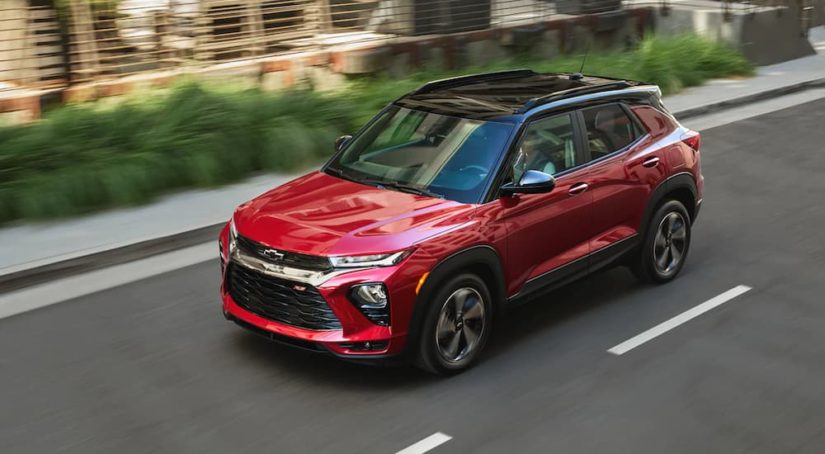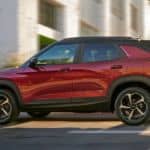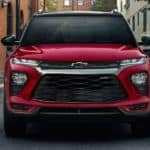After a long hiatus, the 2021 Chevy Trailblazer is finally back on the scene. Historically one of Chevy’s midsize offerings, the vehicle has been reimagined with current tastes in mind and returns as a subcompact SUV. The Trailblazer had been out of production since 2009 when it was replaced with the Traverse crossover SUV. However, with the subcompact trend holding strong, Chevy has decided it’s the perfect time to reintroduce a smaller version of the SUV onto the market.
Based on the early response, the timing couldn’t have been better. The Trailblazer quickly jumped to near the top of its class, maintaining a firm standing in the market. While nostalgia value certainly plays a role in this rapid success, Chevy’s ability to retool a classic model to satisfy the particular demands of today’s consumers can’t be underestimated.
With a starting MSRP of just $19,000, the Trailblazer offers real value within its market segment. The subcompact slots nicely into Chevy’s stable of SUV offerings just between the smaller Trax and roomier Equinox, giving drivers a new option wrapped in a familiar package. While the Trailblazer might lack the sportier tuning and raw power of some of its competitors, it’s more than adequate for the type of driving most often demanded of the subcompact class.
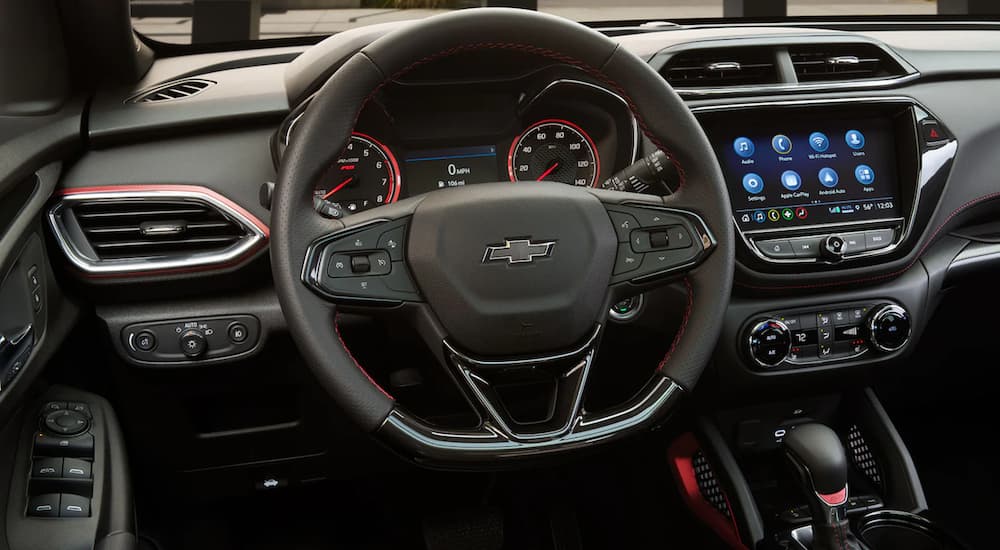
A Modern Makeover
The 2021 Trailblazer replaces the Cruze in Chevy’s lineup, continuing the trend of auto manufacturers ditching traditional sedans for trendier subcompact SUVs. In many respects, this bit of family history serves as a useful hint at the true role of the Trailblazer in Chevy’s arsenal. While the Trailblazer might lack the beefier powertrain of many of its more full-size SUV-leaning counterparts, it is, compared to the sedan it replaced, a logical fusion of a smaller vehicle’s size and price point with the higher clearance and sportier styling consumers have come to associate with SUVs.
The Trailblazer is available with two engine options, a 1.2 liter and a 1.3 liter 3-cylinder EcoTec Turbo. The former is available only in front-wheel drive and offers a more efficient continuously variable automatic transmission (CVT). The 1.3 liter can be front-wheel drive or upgraded to all-wheel drive, with either the CVT or a nine-speed automatic transmission. A MacPherson strut front suspension and Watts link rear suspension give the smaller SUV uniquely peppy handling, making up for the lack of raw power with a level of comfortable maneuverability some of its larger competitors lack.
One aspect that truly separates the Trailblazer from the crowd is its sporty aesthetic. The front fascia has the intricate detail work one might expect from a luxury SUV and the bold design lines running along the sides give the crossover a sporty, race-inspired feel. The distinct styling approach is even more pronounced with the ACTIV trim, which upgrades the Trailblazer with a two-tone roof, front and rear fascia, and dual exhaust. On the functional side, the ACTIV trim includes suspension enhancements and sport terrain tires, which allow the Trailblazer’s feel to match its sporty styling.
“Slotting between the Trax and Equinox, the addition of the Trailblazer provides us with a great opportunity to expand the Chevy SUV family to new audiences,” said Steve Majoros, director of Chevrolet passenger car and crossover marketing. “With the new ACTIV trim, plus the sporty RS trim, we can appeal to customers’ varying active lifestyles.” There is a lot to love with this smaller SUV.
The Trailblazer’s interior is less flashy but just as functional. The lower price point is reflected in the largely plastic interior, but it’s styled in such a way that allows it to punch above its weight. Cargo space is one of the interior main selling points, with not only fold-flat seats but a folding front passenger seat which allows items the size of small kayaks to be accommodated with ease.
The Trailblazer vs the Blazer
The Trailblazer might share part of its name with the Chevy Blazer, but the two vehicles really offer two entirely different driving experiences. Another model revived from the Chevy archives, the Blazer, reappeared on the scene in 2019. The enthusiastic response to the legacy model paved the way for the reintroduction of the Trailblazer itself. For those interested in a Chevy but unsure of which model fits their needs, a side-by-side comparison can be useful.
The Blazer, a true midsize SUV, is larger with more interior cargo space and a 4-cylinder, 2.5-liter engine. With 193 horsepower as opposed to the Trailblazer’s base 137 horsepower, the Blazer is the more powerful of the two. That power does come at the expense of fuel efficiency, with the Trailblazer beating its midsize rival by nearly 8 miles per gallon across the board. The price difference also cannot be ignored, with the entry-level Trailblazer ringing it at almost $9,000 less than the Blazer.
Overall, the Blazer is more of a workhorse, while the Trailblazer is a peppier, more efficient vehicle for everyday use. The Blazer is 1.5 feet longer than the Trailblazer, with a wider wheelbase and 10 extra cubic feet of cargo capacity, but sacrifices fuel economy for size offering 21 miles per gallon city and 27 miles per gallon highway to the Trailblazer’s 28 miles per gallon city and 21 miles per gallon highway. To this end, the
On the inside, the two vehicles stack up a little more closely. Both feature a full suite of leading safety measures, including rear vision cameras, Forward Collision Alert, Front Pedestrian Braking, Automatic Emergency Braking, Lane Keep Assist with Lane Departure Warning, and a Following Distance Indicator. On the technological side of things, both models feature Chevy’s Infotainment 3 System, which includes connectivity for Apple CarPlay, Android Auto, and Bluetooth. The Blazer includes a slightly larger touch screen and eight-speaker Bose audio system over the Trailblazer’s six-speaker setup.
Again, despite the similarity in names, the Trailblazer and Blazer are truly aimed at different segments of the market. The Blazer is more well-equipped in a way one would expect from a model that costs $9,000 more, but some of its features, especially when it comes to the powertrain, might be overkill for drivers who don’t intend on towing larger items or regularly facing tough weather conditions. The Trailblazer, while less powerful than some of its competitors, is a more nimble crossover adept at navigating narrow city streets and squeezing into the tightest of parking spots.
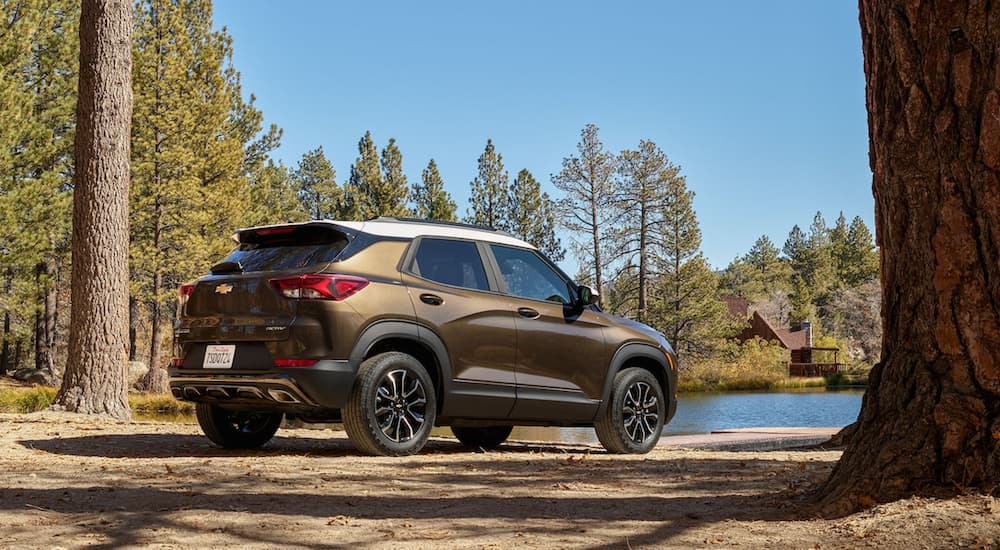
Try Something New
Overall, the Trailblazer is a welcome addition to the current lineup of Chevy SUVs. While smaller than the average offering, its modest price point, impressive fuel efficiency, and distinctive styling make the Trailblazer the perfect option for those looking to make the switch to an SUV. Drivers who are more comfortable with traditional sedans will appreciate the size and economy while still getting the cargo benefits and elevation of an SUV.
The crossover trend has brought a lot of new names onto the market in recent years, but the reimagined 2021 Trailblazer is a shining example of a classic coming out of the archives to reclaim its place in the spotlight. Though it is new again to the market, the Trailblazer is already making a name and a place for itself. So, if you are looking for a smaller SUV with the handling of a sedan but enough room for your passengers and cargo, it’s time to check out the 2021 Chevy Trailblazer.
